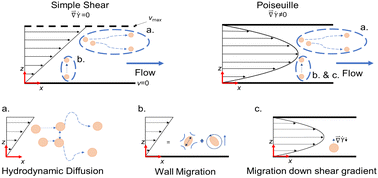Application of droplet migration scaling behavior to microchannel flow measurements†
Abstract
In confined channels in low Reynolds number flow, droplets drift perpendicular to the flow, moving across streamlines. The phenomenon has proven useful for understanding microfluidic droplet separation, drug delivery vehicle optimization, and single-cell genomic amplification. Particles or droplets undergo several migration mechanisms including wall migration, hydrodynamic diffusion, and migration down gradients of shear. In simple shear flow only wall migration and hydrodynamic diffusion are present. In parabolic flow, droplets also move down gradients of shear. The resulting separation depends on parameters including particle size and stiffness, concentration, and flow rate. Computational methods can incorporate these effects in an exact manner to predict margination phenomena for specific systems, but do not generate a descriptive parametric dependence. In this paper, we present a scaling model that elucidates the parametric dependence of margination on emulsion droplet size, volume fraction, shear rate and suspending fluid viscosity. We experimentally measure the droplet depletion layer of silicone oil droplets and compare the results to theoretical scaling behavior that includes hydrodynamic diffusion and wall migration with and without an added shear-gradient migration. Results demonstrate the viability and limitations of applying a simple scaling behavior to experimental systems to describe parametric dependence. Our conclusions open the possibility for parametric descriptions of migration with broad applicability to particle and droplet systems.



 Please wait while we load your content...
Please wait while we load your content...